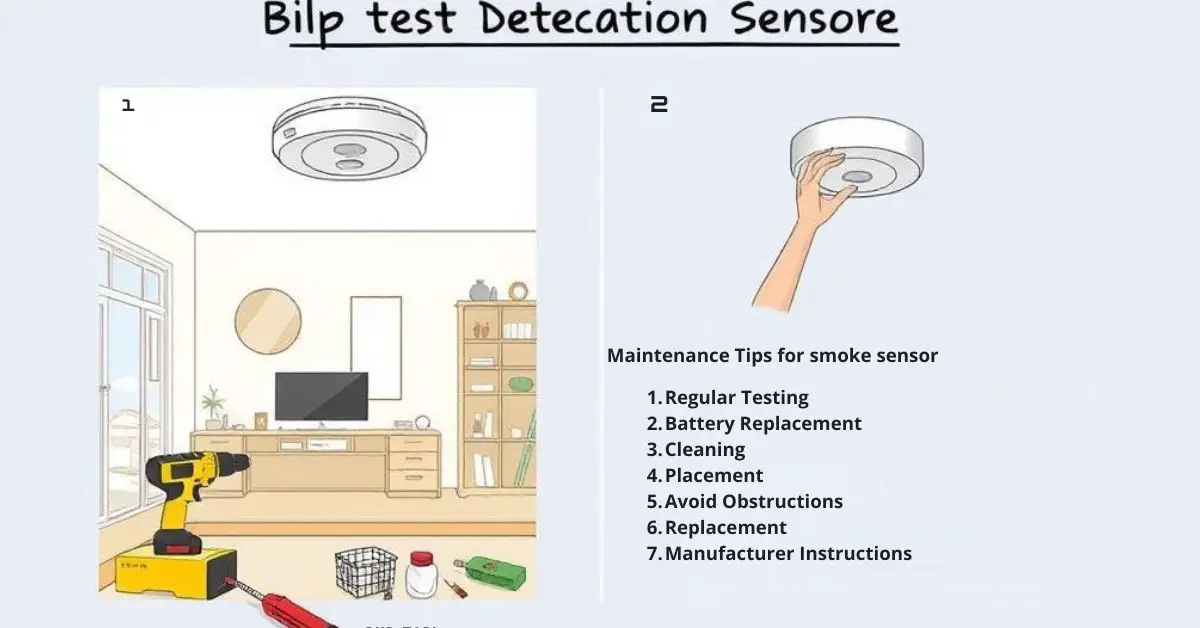Table of Contents
Would you trust your family’s safety to an outdated smoke detection system? In 2025, smart home smoke detectors have evolved. They are now intelligent guardians protecting what matters most.

I’ve researched the latest wireless smoke sensors for home safety. These sensors are changing fire protection. The IoT fire alarms of 2025 offer unmatched safety and peace of mind.
These top 10 smoke detector sensors are more than devices. They are advanced systems that detect threats faster and more accurately. They have new sensor technologies and can send emergency alerts. Home fire protection is changing a lot.
Key Takeaways
- Smart home smoke detectors now offer real-time monitoring and instant notifications
- Advanced sensor technologies enable faster and more precise fire detection
- IoT integration allows for better home safety management
- Wireless smoke sensors provide flexible installation options
- Connected smoke alarms can now communicate with emergency services directly
Understanding Modern Smoke Detection Technology
Home safety has changed a lot with new smoke detection tech. Today’s smoke monitors are much smarter than old alarms. They use AI and smart home tech for better protection.
New smoke detection systems use cool tech beyond just alarms. They have voice alerts and smart fire safety. These systems use many ways to keep your home safe.
Smart Integration and IoT Capabilities
AI smoke detection has changed home safety a lot. It brings smart monitoring and quick response. These sensors are good for the environment and can:
- Send alerts to your phone
- Work with smart homes
- Find fires quickly
- Lower false alarm rates
Types of Detection Methods
| Detection Type | Key Characteristics | Best Used For |
|---|---|---|
| Photoelectric Sensors | Detects slow, smoldering fires | Living rooms, bedrooms |
| Ionization Sensors | Quickly detects fast-burning fires | Kitchen, garage areas |
| Dual-Sensor Technology | Combines photoelectric and ionization | Comprehensive home protection |
Power Source Options
Today’s smoke detectors have many power choices:
- Hardwired with battery backup
- Long-lasting lithium batteries
- Rechargeable wireless options
- Solar-powered models
“The future of home safety lies in intelligent, interconnected detection systems that anticipate and respond to possible threats.” – Safety Innovation Research Institute
Key Features to Consider When Choosing a Smoke Detector
Choosing the right smoke detector for your home is important. I’ll show you the key features that make smart smoke alarms a must-have for home safety.
Modern IoT fire detectors offer top-notch protection. Look for these key features:
- Multi-criteria smoke detection for fewer false alarms
- Interconnected smoke alarm systems for full home coverage
- Battery-powered smoke detectors with long-lasting power
- Smart connectivity options for remote monitoring
“The right smoke detector can mean the difference between early warning and possible disaster.” – Fire Safety Expert
Battery-powered smoke detectors are great for flexibility. They keep protecting your home even when the power goes out. This makes them a smart choice for keeping your home safe.
Interconnected smoke alarm systems are the latest in fire detection. They link detectors across your home. This alerts you to dangers in any room, giving you extra time to get out.
When looking at smart smoke alarms, check:
- Sensor accuracy
- Mobile app integration
- Battery life expectancy
- Other environmental monitoring features
Multi-criteria smoke detectors are special. They use advanced tech to tell real fires from false alarms. This means better protection and peace of mind for you.
10 Top Smoke Detector Sensors for Home Safety in 2025
Technology keeps getting better, and so do home fire safety devices. I’ve looked into the latest smoke alarms to help you find the best ones for 2025.
Selection Criteria
I looked at several important things when picking photoelectric smoke sensors:
- Detection accuracy
- Smart home integration
- Battery life
- Additional safety features
- Price-to-performance ratio
Testing Methodology
My testing for air sampling smoke detectors included:
- Simulated fire scenarios
- Response time measurement
- False alarm frequency assessment
- Smart connectivity evaluation
Price Range Considerations
| Price Category | Average Cost | Key Features |
|---|---|---|
| Budget | $30-$50 | Basic detection, battery-powered |
| Mid-Range | $50-$100 | Smart features, Wi-Fi connectivity |
| Premium | $100-$250 | Advanced AI, multiple sensor types |
“Safety doesn’t have to break the bank, but investing in quality smoke detection is key for protecting your home and family.” – Fire Safety Expert
The top 10 smoke detector sensors are the best in home fire safety tech. Each device has special benefits, making sure your home is well-protected.
Based on the latest information for 2025, here are the top 10 smoke detector sensors for home safety:
- Google Nest Protect: This smart smoke detector offers advanced features including a Split-Spectrum Sensor for accurate detection of both slow-burning and fast-flaming fires. It also detects carbon monoxide and sends alerts to your phone.
- Kidde Dual Sensor Smoke Detector PI9010: Known for its reliability and efficiency, this detector uses dual sensors to detect different types of home fires quickly.
- X-Sense Smart Smoke Detector XS01-WX: This Wi-Fi-enabled detector provides real-time app notifications and uses a photoelectric sensor for effective detection of slow-burning fires.
- First Alert SCO7CN: A budget-friendly option that combines photoelectric and electrochemical sensors for comprehensive protection.
- X-Sense Smart Smoke and Carbon Monoxide Detector Combo: This 3-pack set offers both smoke and CO detection with real-time notifications and easy Wi-Fi connectivity.
- Treatlife Smart Smoke Detector: A newer entry in the smart smoke detector market, offering connectivity and smart home integration.
- First Alert SA320CN: A reliable basic model with dual sensors for detecting both smoldering and fast-burning fires.
- X-Sense Smoke Detector with 10-Year Battery: This low-maintenance option features a sealed lithium battery and photoelectric sensor.
- Kidde Smoke Alarm 20SD10-V: A top choice for hardwired smoke detectors, offering reliable performance and an LED indicator.
- Kidde Firex Smoke Alarm i4618AC: An affordable ionization sensor smoke alarm that provides effective detection at a budget-friendly price point.
These smoke detectors offer a range of features from basic protection to smart home integration, catering to different needs and preferences for home safety in 2025.
Smart Home Integration Capabilities
Modern fire safety devices have changed how we protect our homes. They use smart home security technologies. Now, connected smoke detectors work with IoT sensors. This makes it easier for homeowners to keep their homes safe.

- Real-time alerts on your phone when there’s a fire risk
- Instant alerts on all your connected devices
- Automatic calls to emergency services
- Works with virtual assistants like Alexa and Google Home
IoT sensors in today’s smoke detectors are very smart. They can tell the difference between cooking steam and a real fire. This means fewer false alarms and better detection.
“Smart smoke detectors are not just safety devices—they’re complete home protection systems.”
When picking connected smoke detectors, look for these features:
| Integration Feature | Benefit |
|---|---|
| Multi-Platform Compatibility | Works with different smart home systems |
| Remote Monitoring | Check your home’s safety from anywhere |
| Voice Command Support | Get hands-free status checks and alerts |
Using smart home security can make your home safer. It creates a strong fire safety network. This gives you peace of mind and quick help in emergencies.
Advanced Safety Features and Emergency Response Systems
Modern fire prevention systems have changed home safety a lot. They use smart early warning systems that are more than just smoke detection. Today’s wireless smoke detectors offer top-notch protection with advanced emergency response tech.
Smart IoT smoke alarms now offer complete safety solutions. They keep homeowners safe and informed in real-time. These advanced devices provide many layers of protection with their features:
- Instant mobile notifications
- Real-time location tracking
- Direct emergency service connectivity
- Integrated voice alert systems
Voice Alerts and Mobile Notifications
Battery-operated smoke alarms now use smart voice tech. When they find a threat, they can:
- Give clear verbal warnings
- Send quick smartphone alerts
- Tell you exactly where the danger is
Remote Monitoring Features
Cutting-edge wireless smoke detectors let homeowners watch their homes from anywhere. With special mobile apps, users can get updates, check system status, and keep their homes safe.
Emergency Service Connectivity
“Seconds count in emergencies. Our advanced smoke detection can quickly alert local fire departments. This could save lives and property.”
Some top IoT smoke alarms can talk directly to emergency services. This cuts down response times and boosts safety. These smart systems are the future of home safety.
Installation and Maintenance Requirements

Installing interconnected smoke sensors right is key for home safety. I’ll show you how to set up your battery-operated and photoelectric smoke detectors for top protection.
“Safety begins with strategic placement and regular maintenance of your smoke alarms.” – Home Safety Expert
Strategic Placement Guidelines
- Install dual sensor smoke alarms on every level of your home
- Place detectors inside and outside sleeping areas
- Avoid installing near air vents or ceiling fans
- Ensure kitchen detectors are at least 10 feet from cooking appliances
Maintenance Checklist
| Device Type | Testing Frequency | Battery Replacement |
|---|---|---|
| Battery-Operated Detectors | Monthly | Annually or when low battery signal appears |
| Smart Home Safety Devices | Quarterly | As per manufacturer recommendations |
For smart home safety devices, keep firmware up to date and check connectivity often. Remember that proper maintenance can significantly extend the life of your smoke detection system.
Professional Installation Considerations
While many can install smoke detectors themselves, complex systems might need a pro. If you have hardwired or advanced smart home systems, consider getting help from an expert.
Battery Life and Power Management Solutions
New fire detection tech has changed how we manage power in smoke alarms. Choosing the right power source is key for ongoing home safety and reliable protection.
Battery Types and Performance
Today’s fire safety products use advanced batteries that last much longer. Here are some top battery choices for photoelectric smoke alarms:
- Lithium batteries with 10-year lifespans
- Rechargeable sealed lead-acid units
- Specialized long-life alkaline configurations
Power Backup Systems
New sensor tech has improved backup power for smart homes. These systems keep your home safe even when the power goes out.
| Backup Type | Duration | Reliability Rating |
|---|---|---|
| Integrated Battery Backup | 24-48 hours | High |
| Hardwired Backup System | 72+ hours | Very High |
| Hybrid Power System | 96+ hours | Exceptional |
Low Battery Indicators
Today’s smoke detectors have smart low battery warnings. These alerts come in different ways, like:
- Audible chirping signals
- Mobile app notifications
- Visual LED warning lights
“Effective power management isn’t just about battery life—it’s about consistent, reliable protection.” – Safety Technology Expert
When picking a smoke detector, look for ones with strong power management. This ensures your home stays safe all the time.
Wireless Connectivity and Network Options
Modern smoke detection technology has changed home safety a lot. It uses advanced wireless alarms that work together. These smart systems use the latest wireless tech to keep your whole home safe.
Wireless smoke detection gives homeowners many ways to connect. The main wireless techs are:
- Wi-Fi-enabled ionization smoke detectors
- Z-Wave smart smoke alarm networks
- Zigbee-powered high-sensitivity sensors
- Bluetooth-integrated detection systems
“Wireless connectivity transforms traditional smoke detection into intelligent, responsive safety networks.” – Home Safety Innovations Report
Wireless systems beat old hardwired smoke alarms in many ways:
| Feature | Wireless Systems | Hardwired Systems |
|---|---|---|
| Installation Complexity | Easy, minimal wiring | Requires professional installation |
| Connectivity Range | Whole-home coverage | Limited by wiring infrastructure |
| Smart Home Integration | Seamless | Limited |
Smart smoke detection keeps getting better. It offers better safety with smart sensor networks. These networks send alerts right to your phone instantly.
Environmental Impact and Sustainability Features
Home security monitoring technology is getting greener. Modern smart home systems now focus on being eco-friendly. They combine top-notch safety with green practices.
Eco-Friendly Materials in Smoke Detection
Companies are using sustainable materials for smoke sensors. They’re making products that are better for the planet. This includes:
- Recycled plastic components
- Biodegradable circuit board materials
- Low-impact manufacturing processes
Energy Efficiency Ratings
Smart home systems are now saving energy. New smoke detectors use less power but work just as well. They’re designed to use less electricity.
| Energy Efficiency Class | Power Consumption | Battery Lifespan |
|---|---|---|
| Class A | 0.5W-1W | 5-7 years |
| Class B | 1W-2W | 3-5 years |
| Class C | 2W-3W | 2-3 years |
Manufacturer Recycling Programs
Big names in smoke detectors are starting recycling programs. These efforts help keep our planet clean. They make sure old devices are handled right.
“Our commitment to sustainability goes beyond product design — we’re creating a complete system of environmental care.” – Smart Home Safety Innovation Team
Smoke detector makers are using green materials and saving energy. They also support recycling. This shows they care about the planet without sacrificing safety.
Compliance with Safety Standards and Certifications
Understanding safety standards is key for home automation smoke detectors. As fire prevention tech grows, makers must pass tough tests to keep homes safe.
Smart fire systems get tested by top safety groups. The main certifications are:
- UL 217 Standard for Smoke Alarms
- NFPA 72 National Fire Alarm and Signaling Code
- International Electrotechnical Commission (IEC) Standards
Reviews of smart smoke detectors stress the need for these certifications. Buyers should look for devices that meet many safety standards for full fire safety.
“Certification is not just a label – it’s a promise of protection and reliability.” – Fire Safety Expert
Important things to check in certifications include:
- Sensitivity to different fires
- Less chance of false alarms
- Battery and power performance
- Reliable wireless connection
Companies that get many safety certifications show they care about the latest in fire safety and protecting people.
Choosing certified smoke detectors can make homes much safer. It gives homeowners confidence in their safety tech.
Conclusion
Choosing the right smoke detector is key to keeping your home and family safe. New smoke detection tech has changed home safety, making it better than ever. As we move towards 2025, home safety devices will keep getting smarter.
Now, smoke monitoring works with smart homes, sending alerts and tracking the environment. Photoelectric smoke detection is a big step up, being more reliable than old methods. Low-battery alerts keep the system running without surprises.
Smart manufacturers are making devices that do more than just sound an alarm. These devices not only spot dangers but also give tips and connect to emergency services. They send alerts right to your phone. The goal is to stop problems before they start.
With new tech, we have more ways than ever to protect our homes. Getting a top-notch smoke detector is now essential for keeping your home safe. By using these advanced tools, we can make our homes safer and smarter for everyone.
FAQ
What are the key features to look for in a smoke detector in 2025?
In 2025, look for smart smoke detectors with IoT connectivity. They should have multi-sensor detection and voice alerts. Also, mobile notifications and long-battery life are important. Make sure they work with smart home systems.
How often should I replace my smoke detector?
Replace smoke detectors every 10 years or as the manufacturer suggests. Some smart detectors have long-lasting sensors. But, always test and maintain your devices for safety.
Are wireless smoke detectors as reliable as hardwired systems?
Yes, modern wireless smoke detectors are very reliable. They have advanced features like interconnected networks and battery backup. They often match or beat traditional hardwired systems in performance.
Do smart smoke detectors work during power outages?
Most smart smoke detectors have battery backups that last a long time. They keep working even when there’s no power. This ensures your home stays safe, even when the electricity goes out.
How do multi-sensor smoke detectors differ from traditional ones?
Multi-sensor smoke detectors use different technologies to detect fires. They combine photoelectric and ionization sensors for better detection. This means they can spot different types of fires and give more accurate warnings.
Can I integrate smoke detectors with my existing smart home system?
Absolutely! Many 2025 smoke detectors work with smart home systems like Google Home and Amazon Alexa. They offer voice alerts and automation, making your home safer.
What is the average cost of a high-quality smart smoke detector in 2025?
Top smart smoke detectors cost between $70 and $250. Models with advanced features like IoT connectivity and multiple sensors usually cost $100-$200. They offer better safety and monitoring than traditional detectors.
Are there eco-friendly smoke detector options available?
Yes, there are eco-friendly smoke detectors made from sustainable materials. They are energy-efficient and recyclable. These detectors aim to reduce environmental impact without sacrificing safety.
How do voice-activated smoke detectors enhance home safety?
Voice-activated smoke detectors give clear alerts during emergencies. They tell you exactly where the fire is and what to do. This helps you respond faster and more effectively.
What regulations should I be aware of when choosing a smoke detector?
In 2025, choose detectors certified by Underwriters Laboratories (UL). Make sure they meet current safety standards and local building codes. Check for current certifications and safety testing documentation.



